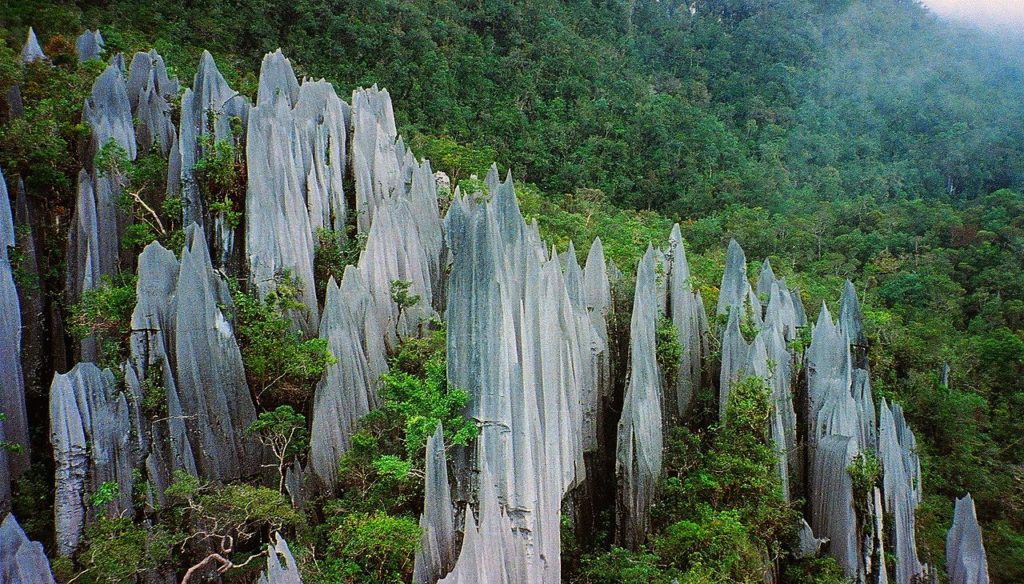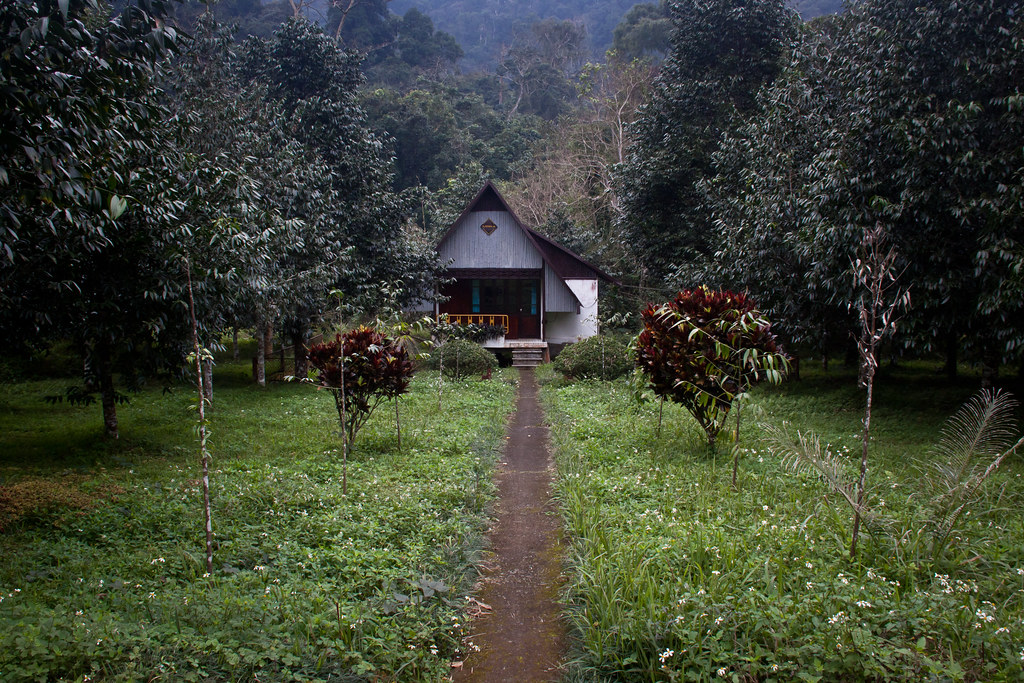1. Gunung Mulu National Park, Malaysia
The Gunung Mulu National Park is a national park in Miri Division, Sarawak, Malaysia. It is a UNESCO World Heritage Site that encompasses caves and karst formations in a mountainous equatorial rainforest setting. The park is famous for its caves and the expeditions that have been mounted to explore them and their surrounding rainforest, most notably the Royal Geographical Society Expedition of 1977–1978, which saw over 100 scientists in the field for 15 months. This initiated a series of over 20 expeditions now named the Mulu Caves Project. The national park is named after Mount Mulu, the second-highest mountain in Sarawak.
 There are 20,000 species of invertebrates, 81 species of mammals, 270 species of birds, 55 species of reptiles, 76 species of amphibians and 48 species of fish identified in the park area. The park has 17 vegetation zones, with 3,500 species of vascular plants, and 1,500 species of flowering plants. There are 109 species in 20 genera of palms, over 1,700 mosses and liverworts, 8,000 species of fungi, and 442 species of spore-producing pteridophytes are recorded
There are 20,000 species of invertebrates, 81 species of mammals, 270 species of birds, 55 species of reptiles, 76 species of amphibians and 48 species of fish identified in the park area. The park has 17 vegetation zones, with 3,500 species of vascular plants, and 1,500 species of flowering plants. There are 109 species in 20 genera of palms, over 1,700 mosses and liverworts, 8,000 species of fungi, and 442 species of spore-producing pteridophytes are recorded
2. Ang Thong National Marine Park, Thailand
 The Ang Thong National Marine Park is a pristine archipelago of 42 islands in the Gulf of Thailand. It features towering limestone mountains, thick jungle, white-sand beaches, waterfalls, and hidden coves and lakes to explore. The protected area of more than 100 sq km of land and sea has a rich biodiversity. Snorkeling, hiking, sea kayaking, diving, and simply relaxing are the main activities to enjoy at Ang Thong.
The Ang Thong National Marine Park is a pristine archipelago of 42 islands in the Gulf of Thailand. It features towering limestone mountains, thick jungle, white-sand beaches, waterfalls, and hidden coves and lakes to explore. The protected area of more than 100 sq km of land and sea has a rich biodiversity. Snorkeling, hiking, sea kayaking, diving, and simply relaxing are the main activities to enjoy at Ang Thong.
3. Cuc Phuong National Park, Vietnam
Cuc Phuong National Park belongs to Nho Quan District, Ninh Binh province, which is bounded between three provinces of Ninh Binh, Hoa Binh, and Thanh Hoa province. It is far about 100 kilometers from Hanoi to the southwest. Cuc Phuong national park is the first national park in Vietnam, established in July 1962. Cuc Phuong National Park has a population of abundant flora and fauna.
 Cuc Phuong has an area of 22.000 hectares, of which three quarters are limestone with a height from 300 meters to 600 meters above sea level. Here, there has May Bac mount with 648.2 meters. The climate in Cuc Phuong is kind of tropical monsoon climate, average annual temperature of about 24.70C. Especially, there have many caves, beautiful landscapes, and historical natural remnants such as Trang Khuyet Cave, Chua Cave, Thuy Tien Cave, Nguoi Xua, Cave, Con Moong grotto, San Ho Cave, etc.
Cuc Phuong has an area of 22.000 hectares, of which three quarters are limestone with a height from 300 meters to 600 meters above sea level. Here, there has May Bac mount with 648.2 meters. The climate in Cuc Phuong is kind of tropical monsoon climate, average annual temperature of about 24.70C. Especially, there have many caves, beautiful landscapes, and historical natural remnants such as Trang Khuyet Cave, Chua Cave, Thuy Tien Cave, Nguoi Xua, Cave, Con Moong grotto, San Ho Cave, etc.
In the Park, there has hot spring at 380 Celcius degree. The flora is various with 1.944 species. Diverse fauna includes 71 species of mammals, 300 species of birds, 33 reptiles, and 16 amphibians.
4.Bokor National Park, Cambodia
Bokor National Park is an excellent national park to visit to learn about diverse flora and fauna. It’s been a wildlife sanctuary for over 100 years and was established to protect Sri Lankan elephants and leopards. Highlights of a trip to this park include the ruins of the Black Palace, the two-tier Popokvil Waterfall, Lok Yeay Mao Monument, and the 100 Rice Fields. The nearest city to this park is Kampot, the capital of Kampot Province in southern Cambodia if you’re looking for hotel accommodations.
 In recent times the national park has become a popular tourist destination and now includes Thansur Bokor Highland Resort, a large luxury hotel built in 2012. In 2010, a large statue of Lok Yeay Mao was constructed in the area. Lok Yeay Mao is a mythic heroine from Cambodian Buddhism and is said to protect travelers, hunters, and fishing men. At 29 metres, it is the tallest Yeay Mao statue in the country.
In recent times the national park has become a popular tourist destination and now includes Thansur Bokor Highland Resort, a large luxury hotel built in 2012. In 2010, a large statue of Lok Yeay Mao was constructed in the area. Lok Yeay Mao is a mythic heroine from Cambodian Buddhism and is said to protect travelers, hunters, and fishing men. At 29 metres, it is the tallest Yeay Mao statue in the country.
According to vietnamtimes.org.vn
(https://vietnamtimes.org.vn/top-10-most-stunning-national-parks-in-asia-37878.html)













